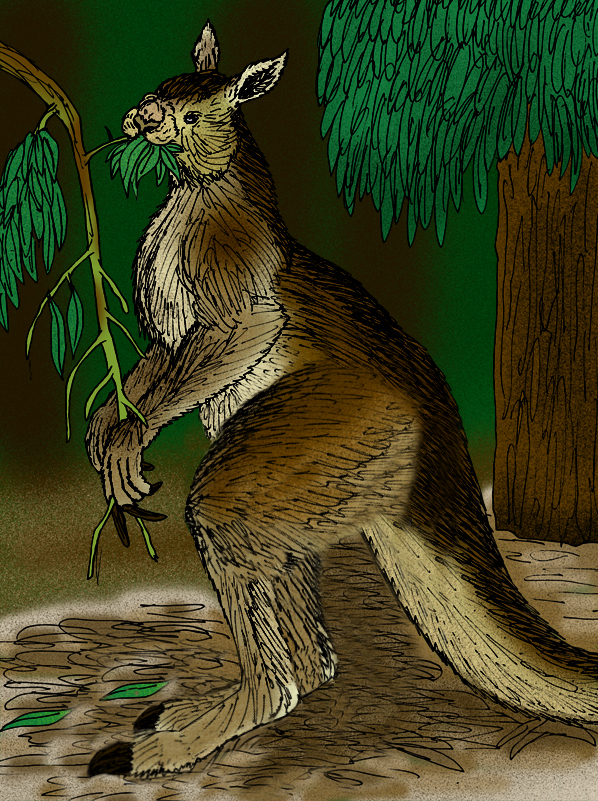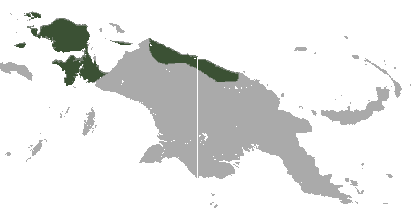|
Macropodidae
Macropodidae is a Family (biology), family of marsupials that includes kangaroos, Wallaby, wallabies, tree-kangaroos, wallaroos, pademelons, quokkas, and several other groups. These genera are allied to the suborder Macropodiformes, containing other macropods, and are native to the Australia (continent), Australian continent (the mainland and Tasmania), New Guinea and nearby islands. Description Although Propleopus, omnivorous kangaroos lived in the past, these were not members of the family Macropodidae; modern macropods are generally Herbivore, herbivorous. Some are Browsing (herbivory), browsers, but most are Grazing, grazers and are equipped with appropriately specialised teeth for cropping and grinding up fibrous plants, in particular grasses and Cyperaceae, sedges. Modern omnivorous kangaroos generally belong to a different family (for example, the Musky rat-kangaroo). In general, macropods have a broad, straight row of cutting teeth at the front of the mouth, no Canine t ... [...More Info...] [...Related Items...] OR: [Wikipedia] [Google] [Baidu] |
Kangaroo
Kangaroos are marsupials from the family Macropodidae (macropods, meaning "large foot"). In common use, the term is used to describe the largest species from this family, the red kangaroo, as well as the antilopine kangaroo, eastern grey kangaroo, and western grey kangaroo. Kangaroos are indigenous to Australia and New Guinea. The Australian government estimates that 42.8 million kangaroos lived within the commercial harvest areas of Australia in 2019, down from 53.2 million in 2013. As with the terms " wallaroo" and "wallaby", "kangaroo" refers to a paraphyletic grouping of species. All three terms refer to members of the same taxonomic family, Macropodidae, and are distinguished according to size. The largest species in the family are called "kangaroos" and the smallest are generally called "wallabies". The term "wallaroos" refers to species of an intermediate size. There are also the tree-kangaroos, another type of macropod which inhabit the upper branches ... [...More Info...] [...Related Items...] OR: [Wikipedia] [Google] [Baidu] |
Marsupial
Marsupials are a diverse group of mammals belonging to the infraclass Marsupialia. They are natively found in Australasia, Wallacea, and the Americas. One of marsupials' unique features is their reproductive strategy: the young are born in a relatively undeveloped state and then nurtured within a pouch on their mother's abdomen. Extant marsupials encompass many species, including Kangaroo, kangaroos, Koala, koalas, Opossum, opossums, Phalangeriformes, possums, Tasmanian devil, Tasmanian devils, Wombat, wombats, Wallaby, wallabies, and Bandicoot, bandicoots. Marsupials constitute a clade stemming from the last common ancestor of extant Metatheria, which encompasses all mammals more closely related to marsupials than to Placentalia, placentals. The evolutionary split between placentals and marsupials occurred 125-160 million years ago, in the Middle Jurassic-Early Cretaceous period. Presently, close to 70% of the 334 extant marsupial species are concentrated on the Australian ... [...More Info...] [...Related Items...] OR: [Wikipedia] [Google] [Baidu] |
Quokka
The quokka (; ''Setonix brachyurus'') is a small macropod about the size of a domestic cat. It is the only member of the genus ''Setonix''. Like other marsupials in the macropod family (such as kangaroos and wallabies), the quokka is herbivorous and mainly nocturnal. The quokka's range is a small area of southwestern Australia. They inhabit some smaller islands off the coast of Western Australia, particularly Rottnest Island just off Perth and Bald Island near Albany. Isolated, scattered populations also exist in forest and coastal heath between Perth and Albany. A small colony inhabits a protected area of Two Peoples Bay Nature Reserve, where they co-exist with the critically endangered Gilbert's potoroo. Description A quokka weighs and is long with a tail, which is quite short for a macropod. It has a stocky build, well developed hind legs, rounded ears, and a short, broad head. Although looking rather like a very small kangaroo, it can climb small trees and shru ... [...More Info...] [...Related Items...] OR: [Wikipedia] [Google] [Baidu] |
Tree-kangaroo
Tree-kangaroos are marsupials of the genus ''Dendrolagus'', adapted for arboreal locomotion. They inhabit the tropical rainforests of New Guinea and far northeastern Queensland, Australia along with some of the islands in the region. All tree-kangaroos are considered threatened due to hunting and habitat destruction. They are the only true arboreal macropods. Evolutionary history The evolutionary history of tree-kangaroos possibly begins with a rainforest floor-dwelling pademelon-like ancestor. This ancestor possibly evolved from an arboreal possum-like ancestor as is suspected of all macropodid marsupials in Australia and New Guinea. During the late Eocene, the Australian/New Guinean continent began a period of drying that caused a retreat in the area of rainforest, which forced the ancestral pademelons to begin living in a drier, rockier environment. After some generations of adaptation to the new environment, the pademelons may have evolved into rock-wallabies (''Petr ... [...More Info...] [...Related Items...] OR: [Wikipedia] [Google] [Baidu] |
Macropodiformes
The Macropodiformes , also known as macropods, are one of the three suborders of the large marsupial order Diprotodontia. They may in fact be nested within one of the suborders, Phalangeriformes. Kangaroos, wallabies and allies, bettongs, potoroos and rat kangaroos are all members of this suborder. Classification * Superfamily Macropodoidea **Family † Balbaridae: (basal quadrupedal kangaroos) *** Genus †'' Galanarla'' *** Genus †'' Nambaroo'' *** Genus †'' Wururoo'' *** Genus †'' Ganawamaya'' *** Genus †'' Balbaroo'' ** Family Hypsiprymnodontidae: ( musky rat-kangaroo) *** Subfamily Hypsiprymnodontinae **** Genus '' Hypsiprymnodon'' ***** Musky rat-kangaroo, ''Hypsiprymnodon moschatus'' *****†'' Hypsiprymnodon bartholomaii'' *****†'' Hypsiprymnodon philcreaseri'' *****†'' Hypsiprymnodon dennisi'' *****†'' Hypsiprymnodon karenblackae'' *** Subfamily † Propleopinae **** Genus †'' Ekaltadeta'' *****†'' Ekaltadeta ima'' *****†'' Ekaltad ... [...More Info...] [...Related Items...] OR: [Wikipedia] [Google] [Baidu] |
Pademelon
Pademelons () are small marsupials in the genus ''Thylogale'', found in Australia, New Guinea, and surrounding islands. They are some of the smallest members of the macropod family, which includes the similar-looking but larger kangaroos and wallabies. Pademelons are distinguished by their small size and their short, thick, and sparsely haired tails. Like other marsupials, they carry their young in a pouch. Etymology The word "pademelon" comes from the word ''badimaliyan'' in Dharug, an Australian Aboriginal language spoken near what is now Port Jackson, New South Wales. The scientific name ''Thylogale'' uses the Greek words for "pouch" and "weasel." Description Along with the rock-wallabies and the hare-wallabies, the pademelons are among the smallest members of the macropod family. Mature male pademelons are larger than females, with an average weight of about 7 kg and height of 60 cm. Mature females weigh around 3.8 kg. Species There are seven recognise ... [...More Info...] [...Related Items...] OR: [Wikipedia] [Google] [Baidu] |
Lagostrophus
The banded hare-wallaby, mernine, or munning (''Lagostrophus fasciatus'') is a marsupial currently found on the islands of Bernier and Dorre off western Australia. Reintroduced populations have recently been established on islands and fenced mainland sites, including Faure Island and Wadderin Sanctuary near Narembeen in the central wheatbelt. Taxonomy The description of the species was published in the 1807 report of a French expedition to Australia. The authors, zoologist François Péron and illustrator Charles Lesueur, described a specimen collected at Bernier Island during their visit to the region in 1801, naming the new species as ''Kangurus fasciatus''. Evidence suggested that the mernine was the only living member of the sthenurine subfamily, and a recent osteology-based phylogeny of macropodids found that the banded hare-wallaby was indeed a bastion of an ancient lineage, agreeing with other (molecular) appraisals of the evolutionary history of ''L. fa ... [...More Info...] [...Related Items...] OR: [Wikipedia] [Google] [Baidu] |
Notamacropus
''Notamacropus'' is a genus of small marsupials in the family Macropodidae, commonly known as wallabies (among other species). The term is derived from the Latin ''nota'' "stripe" and ''macropus'' "kangaroo", referencing the distinct facial stripe of many extant genus members and their phylogenetic relationship to other kangaroos. In 2019, a reassessment of macropod taxonomy determined that ''Notamacropus'' and ''Osphranter'', formerly considered subgenera of ''Macropus'', should be moved to the genus level. This change was accepted by the Australian Faunal Directory in 2020. Species References External links * Macropods Marsupials of Australia Marsupial genera Taxa named by Tim Flannery {{diprotodont-stub ... [...More Info...] [...Related Items...] OR: [Wikipedia] [Google] [Baidu] |
Thylogale
Pademelons () are small marsupials in the genus ''Thylogale'', found in Australia, New Guinea, and surrounding islands. They are some of the smallest members of the macropod family, which includes the similar-looking but larger kangaroos and wallabies. Pademelons are distinguished by their small size and their short, thick, and sparsely haired tails. Like other marsupials, they carry their young in a pouch. Etymology The word "pademelon" comes from the word ''badimaliyan'' in Dharug, an Australian Aboriginal language spoken near what is now Port Jackson, New South Wales. The scientific name ''Thylogale'' uses the Greek words for "pouch" and "weasel." Description Along with the rock-wallabies and the hare-wallabies, the pademelons are among the smallest members of the macropod family. Mature male pademelons are larger than females, with an average weight of about 7 kg and height of 60 cm. Mature females weigh around 3.8 kg. Species There are seven recognised ... [...More Info...] [...Related Items...] OR: [Wikipedia] [Google] [Baidu] |
Wallaby
A wallaby () is a small or middle-sized Macropodidae, macropod native to Australia and New Guinea, with introduced populations in New Zealand, Hawaii, the United Kingdom and other countries. They belong to the same Taxonomy (biology), taxonomic family as kangaroos and sometimes the same genus, but kangaroos are specifically categorised into the four largest species of the family. The term "wallaby" is an informal designation generally used for any macropod that is smaller than a kangaroo or a wallaroo that has not been designated otherwise. There are nine species (eight extant and one Extinction, extinct) of the brush wallaby (genus ''Notamacropus''). Their head and body length is and the tail is long. The 19 known species of Rock-wallaby, rock-wallabies (genus ''Petrogale'') live among rocks, usually near water; two species in this genus are endangered. The two living species of hare-wallabies (genus ''Lagorchestes''; two other species in this genus are extinct) are sma ... [...More Info...] [...Related Items...] OR: [Wikipedia] [Google] [Baidu] |








